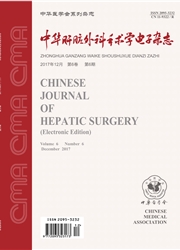

 中文摘要:
中文摘要:
目的探讨他克莫司缓释胶囊在肝移植术后患者中的应用价值。方法回顾性研究2011年1月至2013年12月在中山大学附属第三医院接受诊治的48例肝移植术后患者临床资料。所有患者均签署知情同意书,符合医学伦理学规定。其中男43例,女5例;平均年龄(45±12)岁。根据术后有否应用他克莫司缓释胶囊将患者分为缓释组(18例)和对照组(30例)。两组患者术后早期均采用他克莫司+甲泼尼龙二联免疫抑制方案。缓释组术后20 d开始改用等剂量他克莫司缓释胶囊。比较两组患者他克莫司血药浓度谷值的变化及排斥反应和不良反应的发生率。两组他克莫司血药浓度谷值比较采用t检验;排斥反应及不良反应发生率比较采用χ2检验或Fisher确切概率法。结果缓释组患者血药浓度谷值逐渐下降并于30 d趋于稳定,对照组血药浓度谷值波动较大。缓释组60 d时血药浓度谷值为(7±2)μg/L,明显低于对照组的(10±1)μg/L(t=-15.61,P〈0.05)。缓释组排斥反应的发生率为0(0/18),明显低于对照组的7%(2/30)(P〈0.05)。缓释组肺炎、消化道症状、高血糖、睡眠障碍的发生率分别为33%(6/18)、28%(5/18)、6%(1/18)、6%(1/18),明显低于对照组的77%(23/30)、37%(11/30)、17%(5/30)、23%(7/30)(χ2=18.90,31.53,12.41,45.19;P〈0.05)。结论肝移植术后患者应用他克莫司缓释胶囊可以维持稳定的他克莫司血药浓度谷值,具有良好的抗排斥疗效,并可降低不良反应发生率。
 英文摘要:
英文摘要:
ObjectiveTo investigate the application value of Tacrolimus sustained-release capsules in patients after liver transplantation (LT).MethodsClinical data of 48 patients after LT treated in the Third Afifliated Hospital of Sun Yat-sen University between January 2011 and December 2013 were retrospectively studied. The informed consents of all patients were obtained and the local ethical committee approval had been received. Among the 48 patients, 43 were males and 5 were females with an average age of (45±12) years old. According to whether Tacrolimus sustained-release capsules were given after LT, the patients were divided into sustained-release group (18 patients) and control group (30 patients). The patients in both groups received combined immunosuppressive therapy of Tacrolimus + Methylprednisolone in the early stage after operation. Patients in sustained-release group were given Tacrolimus sustained-release capsules of equivalent dose 20 d after LT. The changes of plasma valley concentration of Tacrolimus and the incidence of rejection and adverse reactions of the two groups were compared. The comparison of plasma valley concentration of Tacrolimus was conducted usingt test, and the comparison of incidence of rejection and adverse reactions was conducted using Chi-square test or Fisher's exact test.ResultsThe plasma valley concentration of sustained-release group decreased gradually and stabilized after 30 d, while that of control group lfuctuated widely. On 60 d, the plasma valley concentration of sustained-release group was (7±2) μg/L, which was signiifcantly lower than (10±1) μg/L of control group (t=-15.61,P〈0.05). The incidence of rejection of sustained-release group was 0 (0/18), which was signiifcantly lower than 7% (2/30) of control group (P〈0.05). The incidence of pneumonia, gastrointestinal symptoms, hyperglycemia and sleep disorders of sustained-release group was respectively 33% (6/18), 28% (5/18), 6% (1/18) and 6% (1/18) , wh
 关于陈规划:
关于陈规划:
 关于陈文捷:
关于陈文捷:
 关于刘波:
关于刘波:
 关于杨扬:
关于杨扬:
 同期刊论文项目
同期刊论文项目
 同项目期刊论文
同项目期刊论文
 Umbilical Cord-Derived Mesenchymal Stem Cells Educate Dendritic Cells to Acquire Tolerogenic Phenoty
Umbilical Cord-Derived Mesenchymal Stem Cells Educate Dendritic Cells to Acquire Tolerogenic Phenoty New diagnosis and therapy model for ischemic-type biliary lesions following liver transplantation--a
New diagnosis and therapy model for ischemic-type biliary lesions following liver transplantation--a 期刊信息
期刊信息
